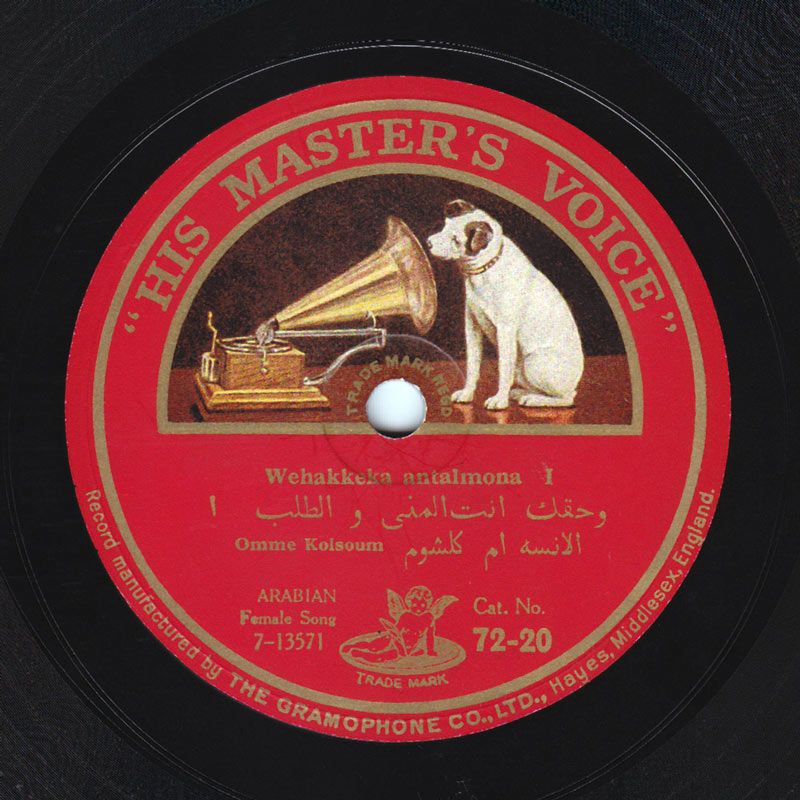Images
All images are courtesy of AMAR Foundation

search

All images are courtesy of AMAR Foundation

The qaṣīda Wa ḥaqqika anta al-muna wa al-ṭalab 2
The Arab Music Archiving and Research Foundation (AMAR), in collaboration with the Sharjah Art Foundation (SAF), presents Sama‘
Let us assume that we have finished talking about the records, even if we haven’t listened to anything.
Anyway, we will at the end of this episode.
Let us give an idea about the public performance of this qaṣīda; I do not imply Sheikh Abū al-‘Ilā’s live performances as we are unable to gather any information about these, but Umm Kulthūm’s performance for example. We do know that Umm Kulthūm used to perform this qaṣīda in her public concerts. How did she perform it, knowing that she had actually memorized it from Sheikh Abū al-‘Ilā’s recording? How did she perform it in her public concerts?
We know for sure that Umm Kulthūm performed waṣlāt in the 1920s and that she sang the very successful qaṣīda Wa ḥaqqika anta al-munā wa al-ṭalab in many concerts. She undoubtedly sang it differently, or added a lot to this recording’s version, especially that the records produced in the 1920s are different from pre-WW1 records. The latter were nothing but a medium attempting to transmit a reflection — unfortunately a distorted reflection — of the period’s musical reality, whereas 1920s records had become a reference and a product by itself. Therefore, we notice that this song became the equivalent of a school exercise aiming to show the performer’s ability to perform maqāmāt, to go higher then lower, and to perform some ornaments. All beginner muṭribāt have sung this qaṣīda in conservatories. Some have recorded their performance and others haven’t.
I have listened to this qaṣīda performed by different muṭribīn in Arab music festivals. Even when listening to a successful muṭriba with a beautiful voice like the Moroccan ‘Azīza Jalāl who recorded this qaṣīda, we notice that she sometimes misses the beat. Yet, the result is almost acceptable in terms of melody, emotion and performance. She does however imitate Umm Kulthūm, but her version is slower.
When comparing the pace of Sheikh Abū al-‘Ilā Muḥammad’s recording to the pace of the performance of a commercial muṭriba who is not specialized in heritage music, we realize that her singing is clearly much slower. These performances do not give us any idea of the way this qaṣīda should be performed. Maybe the only reference that can — not Umm Kulthūm but maybe Sayyid al-Ṣaftī’s generation — is this marvelous recording of Lebanese muṭrib Ṣalībā al-Qaṭrīb singing it for ten minutes, or a little more.
What do we notice when listening to this recording? First: The numerous similar aspects between Ṣalībā al-Qaṭrīb’s voice and performance aesthetics and Sayyid al-Ṣaftī’s. I do not know if he was influenced by Sayyid al-Ṣaftī, knowing that the latter made several visits to Bilād al-Shām (the Levant).
Let us listen to the part starting with Amā wa al-ladhī performed by Sheikh Abū al-‘Ilā Muḥammad, then by Umm Kulthūm, and finally by Ṣalībā al-Qaṭrīb.
In my opinion, the difference is obvious: the original recording of Sheikh Abū al-‘Ilā Muḥammad sounds like an inspiration, an enlightenment; Umm Kulthūm’s version is a successful imitation; Ṣalībā al-Qaṭrīb seems to have been totally imbued in the melody — maybe Umm Kulthūm was also imbued in the melody, but there is unfortunately no recording to prove it — and then added his own creativity.
Let us now listen consecutively to four recordings of this qaṣīda. The first is Sheikh Abū al-‘Ilā Muḥammad’s recording to the bayyātī maqām, followed by his version to the sīkah maqām recorded five years later, then Umm Kulthūm’s imitation of Sheikh Abū al-‘Ilā Muḥammad, and last a live concert by Lebanese muṭrib Ṣalībā al-Qaṭrīb.
Thank you for your listening.